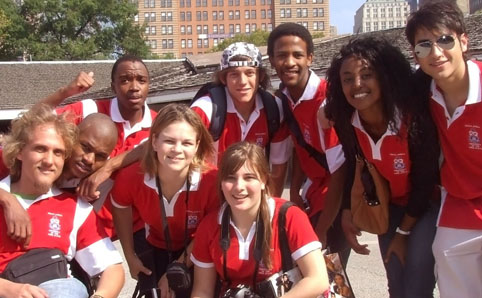 |
|
Some of the students who were chosen in 2010
|
Following the resounding success of the University of the Free State’s (UFS) Student Leadership Development Programme in 2010, the UFS will send a second group of students to the USA in 2011 and also extend the programme by sending students to various universities in Europe and Asia.
This year a total of 150 first-year students will be selected compared to the 71 students that were selected last year. Last year’s group of students spent two weeks, between September and October 2010, at various universities across the United States.
The programme intends to expose the students to diverse cultures and enable them to learn leadership skills. The goal of the programme is to build a new class of UFS students who become leaders during their years of study and commit to building a non-racial community during and beyond their years at university.
Mr Rudi Buys, the UFS Dean of Student Affairs, says: “With the programme we want to develop participants’ thinking and capacity to lead in the contexts of diversity and change and we hope to direct them to programmes leading to change in student life in general upon their return.”
The three core purposes of allowing students an opportunity to study abroad are:
- to introduce South African students to positive models of racial integration and integrated residential life;
- to share and exchange ideas around issues of race, racism, racial integration and racial reconciliation, with undergraduate students abroad; and
- to build long-term networking and collaboration between academics and researchers interested in scholarly work on themes of race, reconciliation and social justice.
Last year students were selected based on their ability to reflect critically on knowledge of societal issues and successful candidates were put through a preparatory development programme. They were divided into groups and given assignments to complete during the programme. A similar selection process will be undertaken this year.
Upon their return, last year’s group of students demonstrated extremely positive outcomes, during an assessment of the project’s goals and achievements. More than 80% of participants agreed that the course met all expectations; the content was meaningful and challenged their existing views. More than 90% felt that the course meaningfully addressed diversity. Among the successes achieved by the programme is the influence of participants in the student community.
Many serve as peer mentors for the Gateway First-Year Welcoming and Orientation Programme, while others serve as mentors in well-being and academic peer advisory programmes. Many have also been elected as members of executive committees of student associations and management committees in residences, while some have availed themselves to run for student governance structures throughout 2011 and 2012.
The programme proved to be so successful that it was decided to expand the number of students selected for the programme to 150 this year and first-year students are invited to apply. It is envisaged that 90 students will visit American universities, while 60 will visit institutions in Europe and Asia.
Last year the students were hosted by, amongst others, Cornell University, the University of New York, Cleveland State University and the University of Massachusetts.
Yale University, Amherst College and other American universities will join these host universities in 2011, in addition to the European and Asian institutions.
Those first-year students who wish to apply can find all the information at
www.ufs.ac.za
Media Release
23 March 2011
Issued by: Lacea Loader
Director: Strategic Communication
Tel: 051 401 2584
Cell: 083 645 2454
E-mail: news@ufs.ac.za